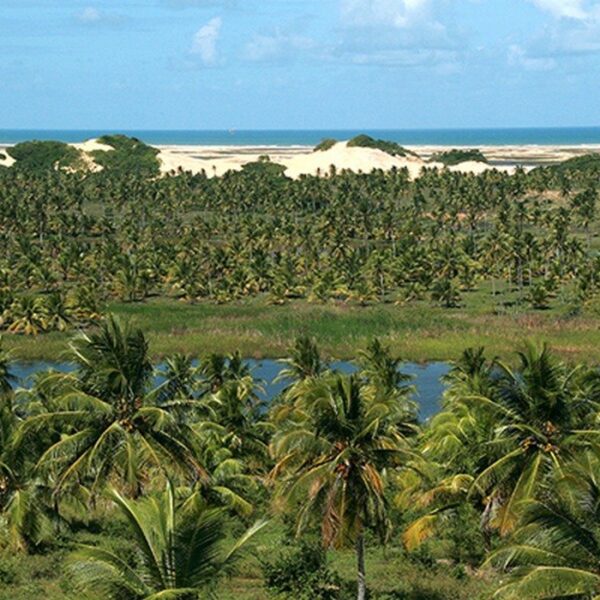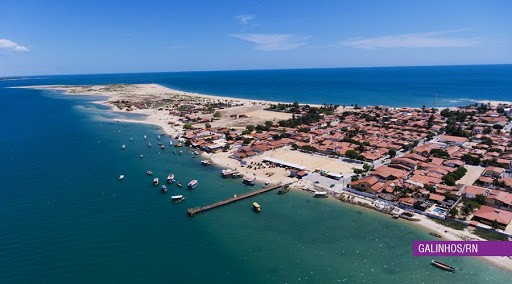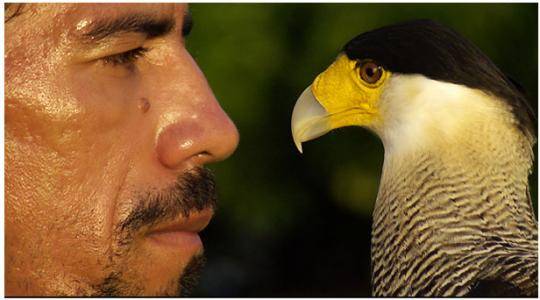Pacatuba is a Brazilian municipality in the state of Sergipe. The beautiful history of the foundation of the municipality of Pacatuba, 116 kilometres from Aracaju, would deserve a separate study. As historians say about the lands that make up this municipality, it is settled on a vast plateau. Pacatuba is a […]
North Coast
The north coast of Rio Grande do Norte is a sequence of villages inhabited by fishermen, always bordered by semi-deserted beaches, with dunes, cliffs and calm waters.
Genipabu: the most famous beach of the North Coast has its dunes up to 30 metres high internationally known as a postcard of Natal.
Genipabu
Genipabu is an obligatory stop for those who want to know the natural beauties of the Region and is well structured to serve the tourist, offering several options for leisure and shopping.
By buggy, the best view is of the Genipabu Lagoon, a freshwater lake surrounded by immense dunes.
The beach is also known for the dromedary ride that starts from the top of the central dunes and for the extreme sports practised on site, such as para-buggy (parachute pulled by buggy and the original esquibunda (wooden board imitating a ski that slides over the dunes to the seashore).
Barra do Rio
A small beach cut by the Ceará-Mirim River and offers a charming ferry crossing that leads to the continuation of the buggy ride along the North Coast.
Graçandu
Is also a typical holiday beach for Natal residents and still retains its original features, with fishing villages all along the region.
The tranquillity of Graçandu is ideal for those looking for a more romantic and isolated accommodation itinerary.
This beach is also ideal for extreme sports such as jet-skiing.
Pitangui
Very busy in the summer, Pitangui has one of the most popular carnivals of the North Coast.
The beach has a well-developed property market and a reasonable urban concentration for the average of the region.
The place is also home to one of the most beautiful lagoons in the state, Lagoa de Pitangui, a mandatory stop for buggies and which offers, among other attractions, the aerial cable jump (vertical dive hoisted by cable from the centre of the lagoon).
The lagoon is ideal for a family programme and has excellent infrastructure and services.
Jacumã
Also a holiday option for families from Natal. The beach offers a calm sea with few waves and without much agitation.
The attraction of the place is due to the Jacumã Lagoon, where you can practice the fun esquibunda and aerobunda.
Muriú: offers the visitor tranquillity, shade of coconut trees and fresh water and is ideal for a weekend with the family.
The natural pool, known as “buraco da velha” is one of the attractions, but the beach also offers jet-ski and banana boat rides.
Barra de Maxaranguape
Located in the municipality of Maxaranguape, the beach is bathed by the river of the same name.
The place offers a picturesque setting, framed by the simple life of the local community.
The bar has a lively carnival, but outside this time is calm all year round, being a popular place for tourists and Natal for the summer.
Cabo de São Roque
Access is by ferry, departing from Barra de Maxaranguape. Cabo de São Roque is known as the true “corner of Brazil”, as it is the closest point to the African continent.
The beach is worth a visit for its natural beauty and unforgettable images such as the São Roque Lighthouse and the “Tree of Love”.
Ponta Gorda
It is the extension of Praia do Cabo and those who follow the edge by buggy can enjoy the immense coconut trees and cliffs. The place is almost deserted and offers a marvellous view of the coast.
Caraúbas
Still retains the characteristics of a fishing village. The pools formed by corals are worth a stop for a peaceful swim.
Maracajaú
Has become an attraction for tourists because it offers the famous parrachos, natural pools in the middle of the ocean, formed by the reefs and which can be visited by boat during low tide.
The beach already offers greater infrastructure for bathers and it is located the largest water park in the region.
Pitinga
Has the charm of a fishing village, with dozens of coconut trees by the sea.
A small lighthouse in the middle of the sea and the carcass of an old ship are unforgettable images of the place. The beach is also very popular with surfers.
Punaú: this is a special corner of the North Coast.
The meeting of the Punaú River, of dark waters, the sea and immense white dunes is unique.
The place is a stopping point for buggy rides and offers a good leisure infrastructure. Punaú is perfect for a romantic weekend in the chalets between the river and the sea.
Zumbi
Is an isolated beach on the North Coast, little visited except by families from Natal during the summer. The beach still offers a wild beauty, with immense coconut trees.
Perobas
Also practically a fishing village, Perobas has a coastline almost untouched by tourist exploitation.
For those who like more adventure and contact with the local people, it is possible to rent common fishermen’s houses, negotiated on the spot, and experience for a few days the simple life of the local people.
Rio do Fogo
The municipality of Rio do Fogo on the North Coast has almost 10,000 inhabitants, but despite the town having grown up around the coast, the seafront remains quiet, being visited by locals and Natalians in the summer period.
Touros
The municipality of Touros on the north coast of Rio Grande do Norte is a major centre of development in the region. It is home to the largest lighthouse in Latin America, the Calcanhar lighthouse, and the picturesque Church of Bom Jesus dos Navegantes, built in 1800.
It was on Touros beach that the Marco, known as the Marco de Touros, the oldest attestation of possession by the Portuguese over the Brazilian colony, landed in August 1501. The town is also home to kilometre zero of the BR 101, the highway that cuts across Brazil to Rio Grande do Sul, marked by the portico designed by the famous Brazilian architect Oscar Niemeyer.
Calcanhar
at the tip of the heel is the largest lighthouse in Latin America and second largest in the world, with more than 70 metres high. The lighthouse is open to public visitation daily from 9am to 11am.
Cajueiro
Cajueiro beach is another quiet corner of the coast, and is little frequented by tourists. The place is a spawning point for sea turtles, an endangered animal.
Ponta de Santo Cristo
Ponta de Santo Cristo is still a fishing village, with an open sea beach and almost deserted. Ideal for resting, it is sought after by families from Natal during the summer.
From October to February: ideal for windsurfing and kitesurfing.
São Miguel do Gostoso
The municipality of Gostoso on the North Coast has gained prominence for the curious name given to the town and the beach. São Miguel has been developing rapidly and the strong winds make it a popular spot for kite-surfers and windsurfers.
The beach is beginning to offer some infrastructure for its visitors and is very popular throughout the high season.
Reduto: as the name implies, it is a small and quiet beach, at the northern end of the North-Riograndense coast. Not much visited by tourists.
Tourinhos
Worth a visit, for its almost untouched natural beauty and for the beach with calm sea and white sands.
Marco
On the border with the state of Ceará is Marco beach.
It was there that the Marco de Touros landed and the place remains practically as it was 500 years ago, when the continent was discovered. The preserved place is a journey back in time. It is a quiet beach, little visited by tourists.
Pipa village or Pipa beach is among the main attractions of RN
A complete guide to make the most of the Praia de Pipa or Pipa Village belongs to the municipality of Tibau do Sul, in Rio Grande do Norte (RN). The village of Pipa is among the main attractions of the state of RN and is home to some of the […]
Tourist Route along the north coast of RN – Genipabu, Gostoso and Touros
The North Coast of RN has strong winds, sun, dunes, beaches, cliffs and the potiguar friendliness accompany visitors all along the coast. Many tourists who come to Rio Grande do Norte know the northern stretch of the coast from Natal. Here, I invite you to immerse yourself in more time […]
Galinhos has natural beauties still little explored
Galinhos in Rio Grande do Norte has been emerging as a new tourist destination due to its deserted beaches and the preserved landscape of the region. Its main attraction is the Praia do Farol along with the Farol de Galinhos. The municipality of Galinhos in Rio Grande do Norte is […]
Maracajaú beach has transparent waters and a coral reef
Transparent waters and coral reef are the attractions of Maracajaú beach (praia de Maracajaú) which is 55 km north of Natal. One of the most impressive things about the beach is the colour of the sea water. Maracajaú is the last beach in the municipality of Maxaranguape. The name of […]
Tibau do Sul has the trendy Pipa Beach
Tibau do Sul, on the south coast of Rio Grande do Norte, near Natal. Those who visit Natal can go and return on the same day to, either by bus or car. Tibau do Sul may even be a name not so well known by tourists from different corners of Brazil. […]
Xingó Canyon is a paradise in the hinterland of Sergipe.
Xingó Canyon, on the border between Sergipe and Alagoas, is one of the greatest natural wonders of the Northeast, located 200 kilometers from the capital Aracaju. Considered the fifth largest canyon in the world and the largest navigable canyon, the site has beautiful rocky walls carved naturally, with the action […]
South coast of Sergipe attracts tourists in search of tranquility
The beaches of the southern coast of Sergipe, about 163 km long between the mouth of the São Francisco River to the north and the Rio Real to the south, still retain many of its beaches practically wild. There are 15 main beaches that make up the Sergipe coast: Praia […]
São Miguel do Gostoso has beautiful beaches and sports
São Miguel do Gostoso is a small paradise very close to Natal (108 km) and is considered one of the best peaks in the world for water sports, the city receives wind and kitesurfers from all over. Each year, the city gains more visibility and new hotel and gastronomic options […]
Falcon Park and the Serra de Itabaiana
Parque dos Falcões is a park dedicated to birds of prey and an attraction in Itabaiana, Sergipe. Falcons, hawks, caracara and owls undergo rehabilitation on site. In the Serra de Itabaiana, tourists visit waterfalls and hike in the forest. Those who choose Sergipe as a tourist route cannot miss Itabaiana, […]
Rio do Fogo in RN has paradisiacal beaches, lagoons and preserved forest
The small municipality of Rio do Fogo, on the Potiguar coast, has a deserted beach, beautiful coconut trees, warm water and lots of fun along the rivers and dunes. The Praia do Rio do Fogo is located in the town of the same name, very close to Natal. The fishing […]
Croa do Goré Island is only available for six hours a day
Croa do Goré Island is a small island of white sand that appears with the movement of the tide. Croa do Goré Island is located in the Vaza-Barris River, between the municipalities of Aracaju, São Cristóvão and Itaporanga d’Ajuda, Crôa do Goré is one of the attractions of the region […]
Ponta dos Mangues beach in the Santa Isabel biological reserve in Sergipe
Ponta dos Mangues in Sergipe is perfect for those seeking tranquility and sea bathing, it is part of the Santa Isabel biological reserve and the reserve was created 25 years ago to preserve the ecosystem. Ponta dos Mangues beach is part of the Santa Isabel biological reserve, an environmental preservation area. The beach […]
Beaches of the South Coast of Sergipe
The south coast of Sergipe offers beautiful beaches with white sand dunes, lagoons and coconut trees and among the most visited are Caueira, Abaís and Saco. At Saco beach, after crossing the Piquitinga and Real rivers, you reach the famous Mangue Seco. This region is known as Costa das Dunas […]
Santa Luzia Island is a refuge for surfers and fishermen in Sergipe
Santa Luzia Island in the municipality of Barra dos Coqueiros are located the beaches of Atalaia Nova, da Costa and Jatobá 1 km from Aracajú, separated only by the Sergipe River. There are also mangroves, rivers and the Atlantic Ocean, the municipality Barra dos Coqueiros has landscapes that leave any […]
Barra do Cunhaú is a destination for those who enjoy extreme sports and nature
Barra do Cunhaú is in the municipality of Canguaretama and is very popular with families with children and people who are looking for peace and quiet. The first impression of those who arrive at the entrance of Barra de Cunhaú is that of being in front of a huge freshwater […]



































